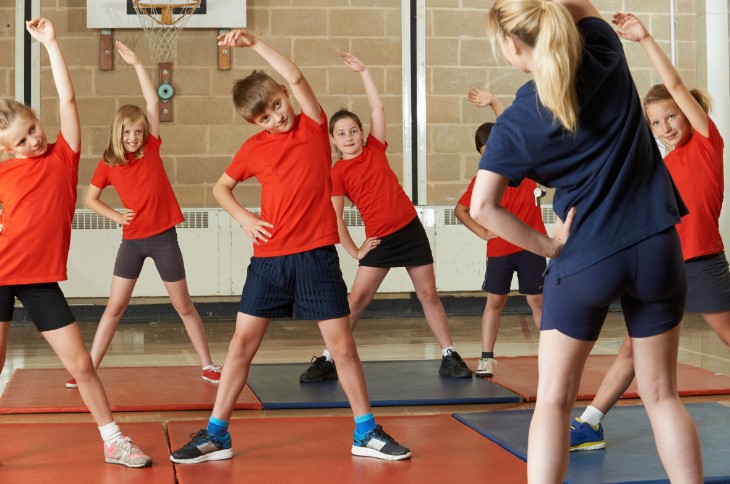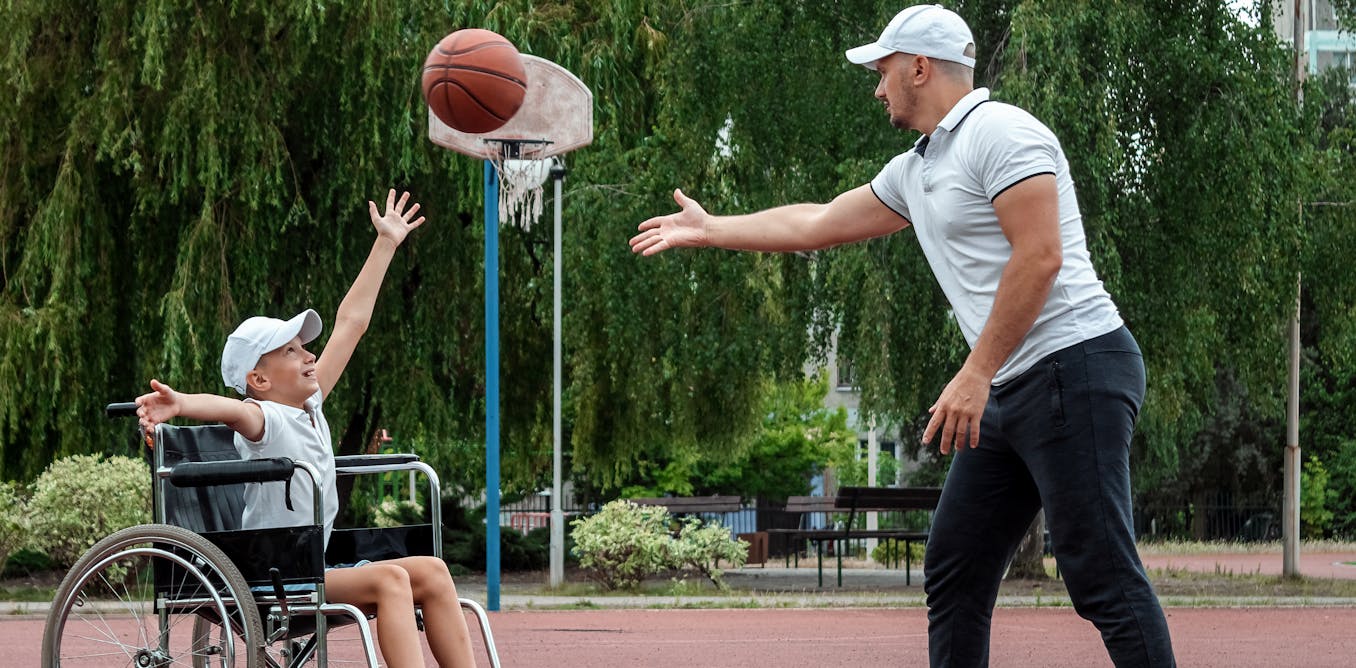The Need for More Physical Education in Colorado Schools has UNC Alumni, Faculty and Doctoral Students Leaping for Change


Once a week, a group of nine-year-old students get up from their desks, form a line
and walk down the hall to the gymnasium at Jackson Elementary in Greeley. There they’ll
begin a short game of tag for less than 10 minutes to get the blood flowing and then
jump right into a fitness activity. The activity is not a typical, run-around-the-basketball-court
kind of workout though, the students participate in a card-game-turned-exercise circuit.
“We play UNO Fitness,” said UNC alumnus and physical education teacher at Jackson
Elementary, Jioni Reliford ‘12.
For nearly a decade, Reliford has been finding new, impactful ways to incorporate
health into his students’ days. For example, in UNO Fitness, Reliford created a board
explaining what the meaning of each UNO card has transformed into. The ‘skip’ card
means skip one lap, any blue card means head over to the jump ropes, a red card means
go to the curl-up station and so on.

Fourth grade students at Jackson Elementary playing UNO Fitness
“We’re really trying to make these fitness activities fun in a way that the students
are not really relating it to working out,” Reliford said.
After the fitness activity comes a lesson focus where a sport or activity is highlighted.
Recently, it was hockey. Reliford first showed his students a short video of a young
female playing the sport to encourage everyone to participate and explain the terminology.
“It gives them background information. We have a lot of students in Greeley from different
countries and they may have never heard of hockey,” Reliford said. “So, if I start
by saying ‘we’re going to work with the puck’ they’ll have no clue.”
Reliford’s goal is to incorporate life lessons into his physical education class plans
to go along with movement, heart rate and fitness zones. He even incorporates literacy
learning when he asks his students to spell ‘dribble’ while dribbling a soccer ball
or hockey puck. Reliford learned the importance of well-rounded health and how to
teach it while he was attending the University of Northern Colorado (UNC) as a Sport
and Exercise Science student.
“A lot of people have the stigma that we’re in here just playing dodgeball, but it
was amazing at UNC because we had outdoor adventure courses and different tactical
game approaches that taught us physical education is much more than that,” Reliford
said.
As a teacher preparation institute, those in UNC’s College of Natural and Health Sciences
take pride in pushing for more physical education classes to continue to evolve like
Reliford’s, though there is an uphill battle to overcome.
Push to Require More Physical Education Hours in Colorado Schools
Regardless of his hard work and thoughtful curriculum, Reliford’s students only have
physical education once a week, a schedule many experts feel is not enough to combat
increased rates of childhood obesity or provide necessary benefits to cognitive ability
and brain development.
“We’re one of only four states in the nation that has no requirement for physical
education K-12,” said Jaimie McMullen, Ph.D., associate professor in the School of Sport and Exercise Science.
McMullen is one of many faculty members working toward more consistent state-wide
physical education policies.
“Right now, some kids will get physical education every third day because it will
rotate with art and music or once every six days,” McMullen said. “In some Colorado
middle school cases though, students never take physical education.”
McMullen says this depends on how a school frames its electives. If students are allowed
two electives per trimester for example, and a student chooses to take band and a
foreign language class, which are full-year electives, there is no time left for physical
education.
“So, in six through eighth grade when their bodies are changing, they never learn
about health, wellness, teamwork and communication,” McMullen said.
McMullen is also a member of the Society of Health and Physical Educators (SHAPE Colorado).
The organization recently advocated for a piece of legislation that had bi-partisan
support, that will determine how beneficial quality physical education is for students.
The pilot program is called Health and Wellness Through Comprehensive Physical Education.
McMullen, her colleagues and doctoral students are currently two years into the evaluation
of the program.
According to the Colorado State Health Department, more than 1 in 4 children in Colorado were overweight or obese in 2013.
In 2014, the Colorado Child Health Survey found only 45.2{e4f787673fbda589a16c4acddca5ba6fa1cbf0bc0eb53f36e5f8309f6ee846cf} of Colorado kids, aged
5 through 14, exercise for 60 minutes every day.
“It will look at what will happen when schools are able to implement what we determined
to be quality physical education, which is physical education taken daily, or at least
225 minutes a week for middle schools and 150 minutes a week at the elementary level,”
McMullen said.
The legislation states, not only does physical education instruction reduce childhood
obesity and foster a lifetime commitment to physical activity and healthy lifestyles,
but a 2007 study by the Institute of Medicine found that physical activity also has
a positive impact on cognitive ability and brain development, insomnia, depression,
anxiety and avoiding tobacco use.

Rep. Mary Young visiting one of Jioni Reliford’s class at Jackson Elementary
Until results from the evaluation are released next year, McMullen and SHAPE Colorado
are working to keep this topic running through legislators’ minds. They invited Representative
Mary Young, who is the vice chair of the House Education Committee, to Jackson Elementary
to witness the impressive practices Reliford is applying in his physical education
classes.
“As a master teacher, [Jioni Reliford’s] physical education class is a symphony of
physical activity, social interaction and cooperation interwoven with reading and
math literacy. Who would have thought tag, Uno Fitness and learning how to use a hockey
stick would achieve those goals?” Young asked.
The recognition of Reliford’s dedication to providing quality physical education is
what McMullen was hoping for, but the race continues.
“If every teacher was like Jioni Reliford, we’d be in a much better place, but his
students don’t see him every day, so imagine how great it would be if they did,” McMullen
said.
UNC’s Active Schools Institute Partnering to Develop Expanded Framework for School
Physical Activity Promotion
Beyond the K-12 classroom, UNC faculty, staff and students have been invested in improving
the quality of physical education and physical activity opportunities for K-12 students
in Colorado and beyond through their Active Schools Institute (ASI). Part of the only physical education graduate program in the state and housed
in UNC’s School of Sport and Exercise Science, the ASI conducts research and community
engaged scholarship in the area of school physical activity promotion. And they recently
formed a strategic partnership with a national organization called Active Schools.
“The movement was established as part of Michelle Obama’s Let’s Move campaign. UNC and I have been involved since early on,” Director of UNC’s Active Schools Institute and Associate Professor in the School of Sport and Exercise Science, Brian Dauenhauer, Ph.D., said. “Currently, I serve on their strategic advisory council, so being in a leadership
role with the organization allowed us to already have those connections in place.
This strategic partnership sort of built off of those relationships.”
The goal of the two-year partnership, which is set to conclude in summer 2023, is
to help the national organization transition into its next version, informally referred
to as Active Schools 2.0.
“One of the key features of the 2.0 version is that it’s very much directed by evidence-based
practice, with the idea being that we take what we know from the research, and we
help schools, teachers, and administrators put it into action in a way that aligns
with what the evidence says really impacts kids the most,” Dauenhauer said.
UNC doctoral students were brought on board to do some of the research and to help
synthesize what the evidence says about school-based physical activity.
“We’re pulling information out of different articles on what is a promising practice,”
said Lisa Paulson, a doctoral student in UNC’s Physical Education and Physical Activity
Leadership program.
“Physical inactivity amongst youth is one of the most troublesome issues,” added Taemin
Ha, who is also a doctoral student in UNC’s Physical Education and Physical Activity
Leadership program. “We need to keep the conversation of how important physical activity
is going and release more evidence, which will hopefully result in more kids becoming
more active and have a happier life.”
The UNC Active Schools Institute is planning on co-hosting a virtual conference this
August to introduce the field to the new Active Schools framework and will host an
in-person conference in summer 2023 to officially launch Active Schools 2.0.
“We intend to provide professional development for folks and create a culture of what
active schools can look like,” Paulson said. “Our primary goal is to educate people
and build a community so kids can have more opportunities for physical activity.”
— written by Sydney Kern and Alani Casiano, a junior English major at UNC

 Jioni Reliford teaching one of his fourth grade students hockey skills
Jioni Reliford teaching one of his fourth grade students hockey skills Jioni Reliford showing one of his fourth grade classes a video on hockey
Jioni Reliford showing one of his fourth grade classes a video on hockey Fourth grade students at Jackson Elementary playing UNO Fitness
Fourth grade students at Jackson Elementary playing UNO Fitness Fourth grade students at Jackson Elementary participating in a quick warm-up
Fourth grade students at Jackson Elementary participating in a quick warm-up





